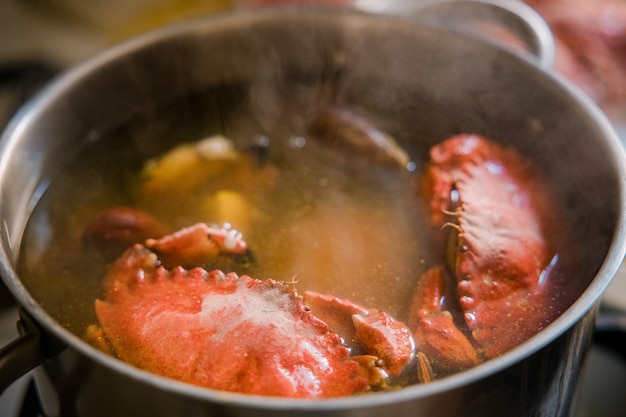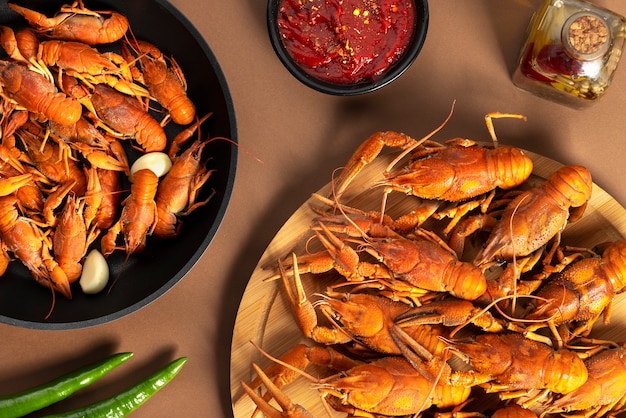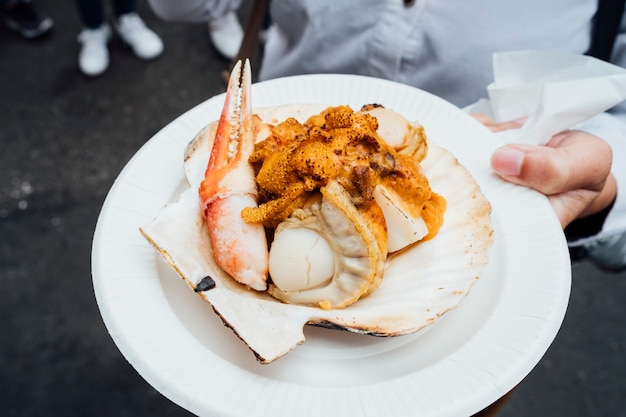(Part 1) - Choosing the Perfect Crab

Where to Buy
Honestly, fishmongers are the true heroes in this story. They usually have a wider variety of crabs and can give you expert advice, tailored to your preferences. I always ask them for the liveliest, freshest crabs they have, as they are the ones most likely to yield the sweetest and tastiest meat. But, if a supermarket is your only option, look for crabs that are firm, have bright, clear eyes, and smell fresh. A whiff of ammonia means you should steer clear – it's a telltale sign of a crab that's past its prime.What to Look for
When you're selecting your crab, here are some key factors to keep in mind:- Size: The size of the crab directly impacts how much meat you'll get. I usually opt for crabs around 1-1.5kg. They're big enough for a satisfying meal but not so large that they become unwieldy to handle.
- Weight: A hefty crab is a good indicator. It means it's packed with meat! A heavier crab for its size is always a good sign.
- Activity: A lively crab is a fresh crab. If it's sluggish or unresponsive, it might be better to choose another. It's a good indicator of the freshness and quality of the crab.
- Shell condition: The shell should be hard, smooth, and free of any cracks or damage. This indicates a healthy crab and a good cooking experience.
Brown Crab or Edible Crab?
Now, here's where things get interesting. Do you go for a brown crab or an edible crab? This comes down to personal preference and what you're looking for in your crab experience. Brown crabs are known for their intense, almost salty, flavour. They're a little tougher to crack open, but the reward is a flavour explosion that's truly worth it. Edible crabs, on the other hand, offer a milder, more delicate flavour and are easier to break into. I tend to gravitate towards brown crabs, but ultimately, the choice is yours.(Part 2) - The Essential Tools

- A large pot: Your pot needs to be large enough to comfortably hold the crab, with plenty of space for water. You want the crab to be fully submerged during the boiling process.
- A steamer basket: This is a must-have for elevating your crab in the pot. It allows for even cooking and prevents the crab from sticking to the bottom, ensuring a delicious result.
- A crab cracker: This is your weapon of choice when it comes to cracking those tough shells. A good crab cracker is an investment worth making.
- A crab fork: This handy tool helps you extract all that delicious meat from the claws and body, leaving nothing behind.
- A mallet: This is optional, but it can be a lifesaver when dealing with exceptionally stubborn shells. A mallet can add extra force for those tricky cracks.
- Gloves: You'll definitely want to wear gloves when handling the crab, especially if it's still alive. They protect your hands from sharp claws and messy juices.
- Paper towels: These are essential for soaking up excess water and keeping your table clean. You'll be grateful for these during your crab feast.
(Part 3) - Preparing the Crab

Cleaning Your Crab
First, give your crab a good scrub. I usually use a stiff brush to remove any dirt or debris from the shell. Don't worry about getting it completely spotless; it's going to get boiled anyway. The main goal is to remove any loose bits that might affect the flavour.The "Knocking" Method
Here's a little trick I learned from an old fisherman – before you boil the crab, give it a gentle tap on the head. I'm not talking about bashing it, just a light knock on the back of its head. This helps to stun the crab, making it easier to handle and potentially preventing it from struggling too much during the boiling process.(Part 4) - Boiling Time
The boiling process is where the magic happens, where your crab transforms from a raw crustacean into a culinary masterpiece.Get the Water Right
Fill your pot with enough water to fully cover the crab. You want to ensure there's enough water to keep it submerged throughout the entire cooking process. Fresh, cold water is the best choice.Add Your Seasoning
Now, this is where you can really let your creativity shine! Traditionalists will tell you to stick with salt and a few peppercorns, but I like to add a bit more flavour. I usually throw in a handful of bay leaves, some fresh thyme, and a few sprigs of parsley. You can also add other aromatics like garlic, onions, or even a dash of chilli flakes, depending on your taste. Experiment and find your perfect blend!Bring it to a Boil
Once the water is at a rolling boil, carefully lower the crab into the pot. Be gentle, and try not to splash yourself! If you're using a steamer basket, place the crab inside first.The Boiling Time
The boiling time depends on the size of the crab. For a 1-1.5kg crab, I typically boil it for 20-25 minutes. If you have a smaller crab, you can reduce the boiling time accordingly. You'll know it's cooked when the crab is a vibrant red colour, and the meat is firm to the touch.(Part 5) - Cooling and Cracking
Your crab is now perfectly cooked. Time to cool it down and get ready for the most satisfying part - cracking it open and enjoying that delicious meat!Cooling the Crab
Once the crab is done, carefully lift it out of the pot and transfer it to a large bowl filled with cold water. This helps to cool it down quickly, preventing overcooking and ensuring that the meat stays tender.Cracking the Crab
Now for the fun part! Put on your gloves and grab your trusty crab cracker. Start by cracking open the claws. It takes some force, but don't be afraid to put some muscle into it. Once the claws are open, use your crab fork to extract the meat. Next, tackle the body. Begin by cracking open the back of the shell. There's a generous amount of meat inside, but it can be a bit tricky to access. Use your crab fork and your fingers to work it loose. Don't forget about the legs! There's some delicious meat tucked away in there too. Use your crab cracker and fork to carefully extract it.(Part 6) - Serving Up
You've successfully boiled and cracked your crab! Now it's time to present this culinary masterpiece.Preparing the Crab
Before serving, use a small knife to remove the intestines and gills from the body. You don't want to eat those! You can also remove the mouthparts from the claws.Presentation
There's a certain art to serving crab. You can get fancy and use a crab-picking set, but I find a simple, rustic approach works best. I usually serve the crab on a large platter, with a pile of paper towels for wiping fingers. This creates a relaxed and inviting atmosphere for the feast.Accompaniments
No crab feast is complete without some accompaniments. A good dollop of melted butter is a must-have. It adds a rich, creamy flavour that complements the crab beautifully. You can also serve it with lemon wedges, crusty bread for soaking up those delicious juices, and a side salad for a refreshing contrast.(Part 7) - Enjoying the Feast
You've done it! Your crab is ready to eat. Take your time, savour the flavours, and enjoy this classic British seaside tradition.Tips for Enjoying Your Crab
Here are a few tips to make the most of your crab feast:- Start with the claws: They're often the most meaty part, offering a satisfying start to your meal.
- Don't be afraid to get messy: Part of the joy of eating crab is embracing the experience – getting your hands a little dirty adds to the fun.
- Dip your crab meat in butter: It adds a rich, creamy flavour that enhances the taste of the crab, taking it to a whole new level.
- Don't forget to eat the legs: They might require a little more effort, but the reward is worth it.
- Share with friends and family: Crab feasts are best enjoyed with good company. It creates a memorable experience and allows you to share the joy of this culinary adventure.
(Part 8) - Leftovers
You've likely got a mountain of crab shells on your table. But, there might be a few leftover pieces of meat. Not to worry, they can be transformed into a variety of delicious dishes!Leftover crab recipes
Here are a few ideas to breathe new life into those leftover crab treasures:- Crab salad: Combine your leftover crab meat with mayonnaise, celery, onion, and lemon juice. Serve it on a bed of lettuce for a refreshing and flavourful salad.
- Crab pasta: Toss your leftover crab meat with your favourite pasta, a little garlic, and some olive oil. This is a simple yet satisfying dish that uses up leftovers in a delicious way.
- Crab cakes: Combine your leftover crab meat with breadcrumbs, herbs, and spices. Form them into patties and pan-fry or bake them for a crispy and flavorful treat.
(Part 9) - FAQs
You've got all the knowledge to boil the perfect crab. Now, let's address some frequently asked questions.1. How do you tell if a crab is dead?
A live crab will have bright, clear eyes, move its legs, and have a firm shell. A dead crab will have cloudy eyes, won't move, and may have a soft or mushy shell. If you're unsure, it's always best to err on the side of caution and choose a different crab.
2. Can you reheat boiled crab?
While it's not ideal to reheat boiled crab as the texture might change, you can always use the leftover meat in other recipes. Crab salad, pasta, or cakes are excellent options to make the most of those leftover treasures.
3. How long can you keep boiled crab in the fridge?
Boiled crab should be refrigerated within two hours of cooking and can be kept in the fridge for up to two days. Make sure to store it properly to maintain its freshness and flavour.
4. Is it safe to eat raw crab?
It's generally not recommended to eat raw crab as it can contain harmful bacteria. However, if you're feeling adventurous, you can try a raw crab dish, but make sure it's prepared by a reputable chef who understands the risks and precautions associated with handling raw seafood.
5. What's the best way to dispose of a crab shell?
The best way to dispose of a crab shell is to break it up into smaller pieces and add it to your compost bin. This allows the shell to break down naturally and enrich your compost. You can also dispose of it in the general waste bin if composting isn't an option.
There you have it! The ultimate guide to boiling the perfect crab. Now, go forth and conquer! Remember, it's all about choosing the right crab, using the right tools, and mastering the art of boiling. And most importantly, enjoy the feast!
Everyone is watching

How to Cook Frozen Lobster Tails Perfectly: A Step-by-Step Guide
RecipesLobster. Just the word conjures up images of lavish meals, special occasions, and a taste of luxury. But let's...

Pigs in a Blanket Cooking Time: How Long to Bake for Perfect Results
RecipesAh, pigs in a blanket. Just the name conjures up images of those delightful little parcels of crispy pastry en...

Pork Fillet Cooking Time: How Long to Cook It Perfectly
RecipesPork fillet, or tenderloin as it's sometimes called, is a real favourite in our house. It's so versatile, and...

The Ultimate Guide to Tender, Juicy Pulled Pork
RecipesRight, let's talk pulled pork. It's one of those dishes that just screams "comfort food," doesn't it? I mean...

The Ultimate Guide to Cooking Sweet Potatoes: From Roasting to Mashing
RecipesSweet potatoes. Just the name conjures up images of warm, comforting dishes, bursts of vibrant color, and a to...
